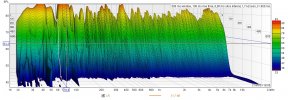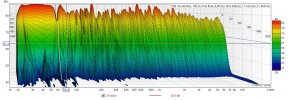Hello and best regards from France,
first sorry for my english and poor sens of humour,
i need some inputs on my REW mesurements, a kind of REW(view) ,
,
my room is 3.5 deep by 4.1m wide, ceiling 2.5m,
back wall is made of 2cm high density foam + akupanels (i thought it would be enough for correct reverberation time, but my mesurements seems to be not as good as excpected)
my usage : 75% Home theater / 25% music
here is the file : https://files.fm/u/jy8ngh3vu
my setup:
AVR : marrantz cinema 50
FRONT : cabasse java mt4 (20 years old)
LFE : svs 2000 pro
TOP : focal icw6 300
SR : cabasse IO2
how does it sound to me ? Good, but can i acheive better?
nosubwoofer on those recordings i just talk about the stereo here (adding the sub is not a good improvement on my system)
here are some pictures:




here are some screen captures with var smoothing
R

L

LR

LR with dirac

i am not sure about interpreting those recordings, how does it look for you?
what do you think i can improve? under 1500Hz seems not very good
shall i go further with room correction? or is correct?
what do you think about L speaker response? is it due too the glass window?
merci par avance / thanks in advance !
first sorry for my english and poor sens of humour,
i need some inputs on my REW mesurements, a kind of REW(view)
my room is 3.5 deep by 4.1m wide, ceiling 2.5m,
back wall is made of 2cm high density foam + akupanels (i thought it would be enough for correct reverberation time, but my mesurements seems to be not as good as excpected)
my usage : 75% Home theater / 25% music
here is the file : https://files.fm/u/jy8ngh3vu
my setup:
AVR : marrantz cinema 50
FRONT : cabasse java mt4 (20 years old)
LFE : svs 2000 pro
TOP : focal icw6 300
SR : cabasse IO2
how does it sound to me ? Good, but can i acheive better?
nosubwoofer on those recordings i just talk about the stereo here (adding the sub is not a good improvement on my system)
here are some pictures:
here are some screen captures with var smoothing
R
L
LR
LR with dirac
i am not sure about interpreting those recordings, how does it look for you?
what do you think i can improve? under 1500Hz seems not very good
shall i go further with room correction? or is correct?
what do you think about L speaker response? is it due too the glass window?
merci par avance / thanks in advance !
Last edited:



